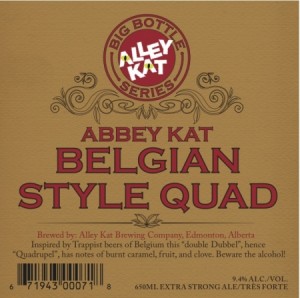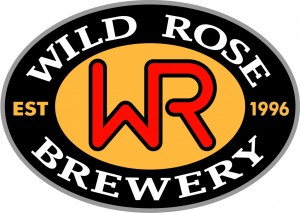 I mentioned a while back that two of Alberta’s breweries in the same week each released a Belgian-inspired seasonal. I have had an opportunity to give them each a try, and am intrigued at how different they are. As a quick refresher, Edmonton’s Alley Kat put out a Quadrupel as their latest Big Bottle, while Calgary’s Wild Rose released a Dubbel as its winter seasonal.
I mentioned a while back that two of Alberta’s breweries in the same week each released a Belgian-inspired seasonal. I have had an opportunity to give them each a try, and am intrigued at how different they are. As a quick refresher, Edmonton’s Alley Kat put out a Quadrupel as their latest Big Bottle, while Calgary’s Wild Rose released a Dubbel as its winter seasonal.
Right off the top I recognize the two beer are supposed to be quite different, yet related. They have the same base characteristics, but Alley Kat’s should be stronger and bolder. It is this difference/similarity dichotomy that makes a side-by-side review intriguing (I normally try not to put one interpretation beside another interpretation – and will do my best to respect each one for what it is).
The Quadrupel pours a mahogany brown with a light tan head that builds into a huge mesa formation. To look at it in the glass reminds me of cola. The aroma has a lot going on: raisin, toffee, rich caramel, dark fruit, some light earthy spicing of clove and pepper, some breadiness. It is very rich smelling; more sweet than spicy, but the spice is present. At first sip I get big toasted caramel and brown sugar. Following that up are hints of clove and possibly cardamom. The middle sharpens up with some musty spices and dark fruit and the beer finishes with a fascinating balance of sweet and sharp. The carbonation is prickly and keeps the beer sharper than it might ordinarily be.I pick up the alcohol a little more than I should on a Belgian Abbey Ale, but that may mellow with time.
I like the balance between the malt character and the spicing. It is not afraid to be all Belgian yeast-y but doesn’t overdue it (which I sometimes find North American breweries can do). It reminds me more of Chimay Blue than some of the Quads that I have sampled in recent years. I also think it could use a little aging to soften some of the rougher edges (I should note the beer is only a couple of weeks old).
 And then I turned my attention to the Wild Rose Dubbel (on a different night so to not create background noise for my palate). This beer is a bit lighter, a red amber hue, but also produces a mountainous white head that offers a moderate amount of lacing down the side of the glass. I am impressed with how sparkling and bright this beer looks. The front of the sip is sweet candy, raising and a underlay of musty earthiness. I get a distinct prune and other dark fruit character. As it beer finishes the spices kicks up a notch, as does some yeastiness. The finish is fairly sweet. The linger has a sharp bite that doesn’t seem quite right for some reason.
And then I turned my attention to the Wild Rose Dubbel (on a different night so to not create background noise for my palate). This beer is a bit lighter, a red amber hue, but also produces a mountainous white head that offers a moderate amount of lacing down the side of the glass. I am impressed with how sparkling and bright this beer looks. The front of the sip is sweet candy, raising and a underlay of musty earthiness. I get a distinct prune and other dark fruit character. As it beer finishes the spices kicks up a notch, as does some yeastiness. The finish is fairly sweet. The linger has a sharp bite that doesn’t seem quite right for some reason.
I really appreciate the start of this beer. I like the dark fruit and musty accent, plus the malt seems spot on. I get distracted in the finish, however. It seems too yeasty and funky, rather than a soft spiciness. I wonder if I simply don’t like the yeast they chose. Yeast is crucially important for Belgian Ales, and every Belgian yeast produces its own blend of esters and phenols. From past experience in my homebrewery, I find I like some strains and not others. I say this because I wonder if my reaction is due to my personal preferences, rather than any particular issue with the beer. However, it is what I experienced, so I must report it as such.
On the surface, it might be hard to see these two beer as siblings, but in a way they are – both for their common stylistic origins and that fact they are made 3 hours drive apart. As I contemplate my impressions of each beer more fully, I start to see the similarities between them. The soft caramel, the dark fruitiness and earthy undertone. The Quad, of course, offers these flavours in a more pronounced fashion. But, just like siblings, they take their own path, guided by the mysterious processes that flow in the fermenter. Plus, I would hazard a guess they used different yeast strains. I wonder what the two beer would be like if they used the same strain?

Leave a Reply